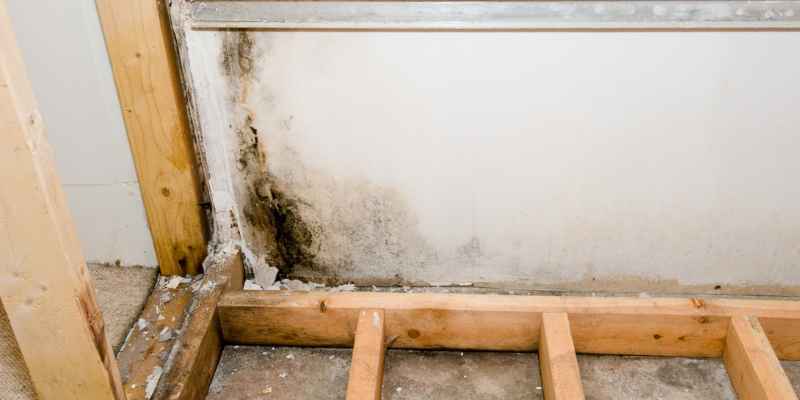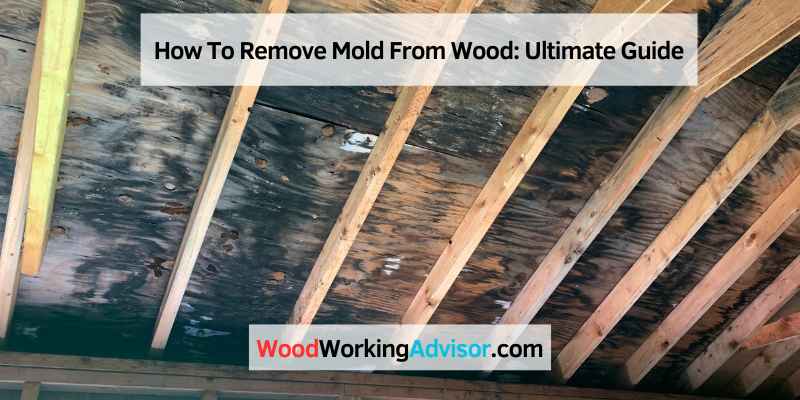To remove mold from wood, scrub the affected area with a mixture of bleach and water using a stiff brush.
Why Mold On Wood Is A Problem
Mold growth on wood can cause various issues, both in terms of health risks and structural damage. It is important to address mold on wood promptly to prevent these problems from worsening.
Health Risks
Mold can have detrimental effects on our health, particularly for individuals with allergies, asthma, or compromised immune systems. When mold spores are inhaled, they can trigger allergic reactions, respiratory problems, and even infections. This is why it is crucial to remove mold from wood as soon as it is detected to avoid risking the health of you and your family.
Structural Damage
Mold growth on wood can cause irreversible damage to the structure itself. As mold feeds on organic matter, it gradually breaks down the wood fibers, weakening the structure. Over time, this can lead to rot, warping, and deformation of the wood. The presence of mold can also cause stains and discoloration, which can ruin the aesthetic appeal of the wood.

Identifying Mold On Wood
Identifying mold on wood is an important step in effectively removing it and preventing further damage. Mold can be harmful to both the structural integrity of the wood and the health of those exposed to it. By understanding the visual signs and musty odor associated with mold on wood, you can take the necessary steps to address the issue promptly.
Visual Signs
There are several visual signs that can indicate the presence of mold on wood. These signs can vary depending on the type and severity of the mold growth. Here are some common visual signs to look out for:
- Discoloration: Mold often appears as patches of black, green, or brown discoloration on the surface of the wood. These patches may be fuzzy in texture or have a slimy appearance.
- Texture changes: Mold growth can cause the wood to become warped, cracked, or crumbly. Pay attention to any noticeable changes in the texture of the wood.
- Stains or spots: Mold can leave behind stains or spots on the wood. These stains may appear as dark spots or streaks on the surface.
Musty Odor
In addition to visual signs, mold on wood often emits a distinct musty odor. This odor is often described as damp or earthy and can become more pronounced in areas with high humidity. If you notice a musty odor near or around wooden surfaces, it could be an indication of mold growth.
Identifying mold on wood is crucial in order to tackle the issue effectively. By being aware of the visual signs and musty odor associated with mold growth, you can take the necessary steps to remove it and prevent further damage. In the next section, we will explore various methods for effectively removing mold from wood.
Preparing For Mold Removal
Learn how to effectively remove mold from wood with these simple steps. By following proper preparation techniques, you can ensure successful mold removal and restore the condition of your wooden surfaces.
Safety Precautions
Mold removal can be a hazardous task, so it’s crucial to take proper safety precautions to protect yourself and prevent further spread of mold. Here are some essential safety measures to follow:
- Wear protective clothing, including goggles, gloves, and a disposable mask, to shield yourself from harmful mold spores.
- Ensure the area is well-ventilated. Open doors and windows and use fans or dehumidifiers to promote air circulation.
- Isolate the affected area by sealing it off from the rest of the house, if possible, to prevent mold spores from spreading.
- Avoid using any electrical appliances, such as fans or heaters, in the vicinity of mold-infested areas to reduce the risk of electrical shock.
Gathering Necessary Supplies
Before you embark on removing mold from wood, it’s essential to gather the necessary supplies to ensure you have everything you need. Here’s a list of items you should have on hand:
- A plastic sheet or tarp to protect surrounding areas from potential contamination during the removal process.
- A stiff-bristle brush or scrub brush to physically remove the mold from the wood surface.
- A non-ammonia detergent or specially formulated mold cleaner to effectively eliminate mold.
- A bucket or container for mixing the cleaning solution.
- A vacuum cleaner equipped with a HEPA filter to remove mold spores after cleaning.
- Clean, dry cloths or rags for wiping and drying the wood.
- A garbage bag for disposing of mold-infested materials.
Methods For Removing Mold From Wood
Mold growth on wood can be unsightly and pose health risks. Fortunately, there are effective methods to remove mold from wood surfaces. Depending on your preferences and the severity of the mold infestation, you can choose between natural remedies and chemical cleaners to tackle this problem.
Natural Remedies
To remove mold using natural remedies, consider the following options:
- Vinegar: Vinegar is a natural disinfectant that can effectively eliminate mold. Simply mix equal parts of vinegar and water in a spray bottle. Spray the solution onto the mold-infested wood and let it sit for at least an hour. Scrub the area with a brush to remove the mold, then wipe it clean with a damp cloth.
- Baking Soda: Baking soda is another natural option for mold removal. Create a paste by mixing baking soda with water until it forms a thick consistency. Apply the paste onto the affected wood and scrub it gently using a brush. Afterward, rinse the area with water and wipe it dry.
- Tea Tree Oil: Tea tree oil has strong antifungal properties that can combat mold growth. Mix a teaspoon of tea tree oil with a cup of water, then apply the solution to the mold-infected wood using a cloth. Allow it to sit for a few hours before wiping it clean with a damp cloth.
Chemical Cleaners
If natural remedies are not sufficient, you can consider using chemical cleaners to remove mold from wood. Here are some effective options:
| Chemical Cleaner | Usage Instructions |
|---|---|
| Bleach | Mix a cup of bleach with a gallon of water. Apply the mixture to the mold-infested wood using a sponge or spray bottle. Allow it to penetrate the wood for about 15 minutes, then scrub the area with a brush. Rinse the wood thoroughly with water and dry it completely. |
| Hydrogen Peroxide | Pour hydrogen peroxide into a spray bottle and apply it directly to the mold. Let it sit for 10 minutes, then scrub the area with a brush. Rinse with water and dry the wood thoroughly. |
| Mold Removal Sprays | Purchase a mold removal spray from your local hardware store. Follow the manufacturer’s instructions to apply the spray onto the mold-infested wood. Remember to wear protective gloves and ensure proper ventilation when using chemical sprays. |
Before using any chemical cleaner, it’s crucial to read the instructions and take necessary precautions to protect yourself and the surrounding environment.
By using these reliable methods, you can successfully remove mold from wood surfaces, restoring their appearance and ensuring a healthier living environment.

Preventing Mold Growth On Wood
Prevent mold growth on wood with these effective techniques. Learn how to remove mold from wood and keep your surfaces clean and protected.
Controlling Moisture
Controlling moisture is key to preventing mold growth on wood. Mold thrives in damp environments, so it’s important to keep wood surfaces dry. Here are some strategies to help you control moisture:
- Repair any leaks or water damage in your home immediately.
- Avoid overwatering indoor plants near wooden surfaces.
- Use dehumidifiers in rooms with high humidity levels.
- Ensure proper drainage around your home’s foundation to prevent water penetration.
Proper Ventilation
Proper ventilation is another essential factor in mold prevention. Good airflow helps to keep moisture levels low and discourages mold growth on wood. Consider the following tips for ensuring proper ventilation:
- Use exhaust fans in areas prone to moisture, such as bathrooms and kitchens.
- Open windows periodically to let fresh air circulate throughout your home.
- Use fans to improve air circulation in enclosed spaces.
- Avoid blocking air vents or grilles with furniture or other objects.
Conclusion
By following the methods and tips outlined in this post, you can effectively remove mold from wood surfaces. Remember to always prioritize safety and wear protective gear when dealing with mold. Regular cleaning and maintenance can prevent mold growth in the future.
Keep your home healthy and mold-free by taking prompt action at the first sign of mold.


